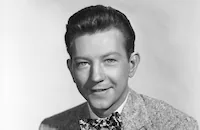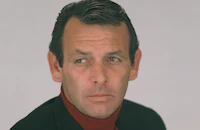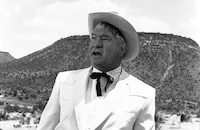Francis Goes to West Point
Brief Synopsis
Cast & Crew
Arthur Lubin
Donald O'connor
Lori Nelson
Alice Kelley
Palmer Lee
William Reynolds
Film Details
Technical Specs

Synopsis
When Pete Stirling's pal Francis, a talking mule, tells him that the atomic defense plant at which Pete works is about to be blown up by terrorists, Pete immediately informs the police. That night, the police and plant guards dismiss Pete as insane when nothing goes wrong and Pete claims his source was a talking mule. As the police prepare to leave, however, Pete, working off another tip from Francis, begs them to stop a water truck entering the plant. When they do, they discover the water is actually an explosive liquid, and Pete is declared a hero. Although Pete is small and not very bright, the Army grants him an appointment to the West Point military academy. There, Pete is befriended by his roommates, football player William Norton and a tough general's son, Wilbur Van Allen, both of whom are nicknamed Bill. The upper-class cadets haze the new students, or "plebes," mercilessly. Pete, who quickly sinks to last in his class, is told that he has two weeks to improve or be thrown out of the school. In a rare act of charity, Francis signs on as a West Point mascot in order to tutor Pete, who helps the plebe rise to twenty-fourth in the class. However, when rival cadet Corporal Ransom pushes Pete to reveal his tutor, and Pete names Francis, he is punished with six weeks of walking duty. During a revue of troops a few days later, Cynthia, the daughter of the commandent of cadets, Colonel Daniels, visits Van Allen and realizes that, although their parents want them to date, Van Allen loves his long-time secret girl friend, Barbara Atwood. After Francis' barked orders to Pete confuse the whole school and ruin the revue, Cynthia flirts with Pete and increases his already severe punishment. That night at a dance, Cynthia and Pete dance until a group of plebes ride a costumed Francis around the dance floor. Pete, who insists that the colonel stop them, receives yet another punishment. The plebes soon graduate, and over the next year, Norton becomes the star of the school's football team, which wins because Francis whispers tips into Coach Chadwick's ear. When the coach confesses to the colonel that he thinks Francis can talk, they force Pete to bring them to the mule, who demonstrates his unique talent to save his friend. Soon after, Van Allen receives a letter from his sister stating that she is pregnant and so must tell her father about her secret marriage. Van Allen decides that it is also time to disclose his love for Barbara, and so leaves for home, over Norton's objections. When Pete finds the letter on Norton's bed, however, he assumes that Norton is secretly married and expecting a baby. Later, when Barbara visits, two officers overhear her talking to Norton about the secret marriage of one of his roommates. The colonel calls in Pete to explain, and the cadet, thinking he is saving Norton's academic and athletic career, pretends he is the married roommate. When Francis sees Pete leaving, he convinces the colonel to hold off on Pete's tendered resignation. That night, Cynthia informs her father that the letter was Van Allen's. At the big football game against Navy the following day, Francis finds Pete in the parking lot, listening sadly as Norton fumbles ball after ball. Francis tells Pete that the letter belonged to Van Allen and Norton is playing poorly because he is concerned for Pete. Pete rushes to the locker room, where Van Allen assures the boys that his father took the news well and Norton thanks Pete for trying to protect him. The coach then brings Francis into the locker room, and his advice leads them to triumph. Later, the colonel attempts to turn Francis over to the research department, but Francis dupes him with a lookalike mule and sneaks off after saying goodbye to Pete, who has reached the top of his class.

Director
Arthur Lubin
Cast

Donald O'connor

Lori Nelson
Alice Kelley
Palmer Lee
William Reynolds

Les Tremayne
Otto Hulett

Dave Janssen

James Best
Francis

Chill Wills

Pierre Watkin
Cliff Clark
Edward Earle
Charles Cane
William Newell
Freeman Lusk
John Damler
Howard Banks

Paul Burke
Sam Flint
Davison Clark
Frank Roehn
Leonard Nimoy
Robert Edgecomb
Bill Fletcher
Tom Irish
Rolland Morris
Roger Mcgee
George Sherwood
Jack Baston
Richard Fortune
Paul Keast
Perc Launders
Anthony Radecki
Ted Jordan
Jay Stafford
Roger Alan
Mark Dennis
Clark Burroughs
Chuck Courtney
Bill Cassady
Tyler Macduff
Claude Dkukin
Ivan Browning
Max Palmer
William Von Gelder
Judy Wiard
Donald Kerr
Walter Clinton
Crew
John Austin
Oscar Brodney
Leslie I. Carey
Milton Carruth
Russell A. Gausman
Joseph Gershenson
Leonard Goldstein
Carl Guthrie
Bernard Herzbrun
Jesse Hibbs
David S. Horsley
Kara
Eric Orbom
Robert Pritchard
Dorothy Ried
Joan St. Oegger
Bud Westmore

Film Details
Technical Specs

Articles
Donald O'Connor, 1925-2003
Born Donald David Dixon O' Connor in Chicago on August 28, 1925, he was raised in an atmosphere of show business. His parents were circus trapeze artists and later vaudeville entertainers, and as soon as young Donald was old enough to walk, he was performing in a variety of dance and stunt routines all across the country. Discovered by a film scout at age 11, he made his film debut with two of his brothers in Melody for Two (1937), and was singled out for a contract by Paramount Pictures. He co-starred with Bing Crosby and Fred MacMurray in Sing, You Sinners (1938) and played juvenile roles in several films, including Huckleberry Finn in Tom Sawyer - Detective (1938) and the title character as a child in Beau Geste (1939).
As O'Connor grew into adolescence, he fared pretty well as a youthful hoofer, dancing up a storm in a string of low-budget, but engaging musicals for Universal Studios (often teamed with the equally vigorous Peggy Ryan) during World War II. Titles like What's Cookin', Get Hep to Love (both 1942), Chip Off the Old Block and Strictly in the Groove (both 1943) made for some fairly innocuous entertainment, but they went a long way in displaying O'Connor's athletic dancing and boyish charm. As an adult, O'Connor struck paydirt again when he starred opposite a talking mule (with a voice supplied by Chill Wills) in the enormously popular Francis (1949). The story about an Army private who discovers that only he can communicate with a talking army mule, proved to be a very profitable hit with kids, and Universal went on to star him in several sequels.
Yet if O'Connor had to stake his claim to cinematic greatness, it would unquestionably be his daringly acrobatic, brazenly funny turn as Cosmo Brown, Gene Kelly's sidekick in the brilliant Singin' in the Rain (1952). Although his self-choreographed routine of "Make "Em Laugh" (which includes a mind-bending series of backflips off the walls) is often singled out as the highlight, in truth, his whole performance is one of the highlights of the film. His deft comic delivery of one-liners, crazy facial expressions (just watch him lampoon the diction teacher in the glorious "Moses Supposes" bit) and exhilarating dance moves (the opening "Fit As a Fiddle" number with Kelly to name just one) throughout the film are just sheer film treats in any critic's book.
After the success of Singin' in the Rain, O'Connor proved that he had enough charisma to command his first starring vehicle, opposite Debbie Reynolds, in the cute musical I Love Melvin (1953). He also found good parts in Call Me Madam (1953), There's No Business Like Show Business (1954), and Anything Goes (1956). Unfortunately, his one attempt at a strong dramatic role, the lead in the weak biopic The Buster Keaton Story (1957) proved to be misstep, and he was panned by the critics.
By the '60s, the popularity of musicals had faded, and O'Connor spent the next several years supporting himself with many dinner theater and nightclub appearances; but just when it looked like we wouldn't see O'Connor's talent shine again on the small or big screen, he found himself in demand at the dawn of the '90s in a string of TV appearances: Murder She Wrote, Tales From the Crypt, Fraser, The Nanny; and movies: Robin Williams' toy-manufacturer father in Toys (1992), a fellow passenger in the Lemmon-Matthau comedy, Out to Sea (1997), that were as welcoming as they were heartening. Survivors include his wife, Gloria; four children, Alicia, Donna, Fred and Kevin; and four grandchildren.
by Michael T. Toole

Donald O'Connor, 1925-2003
Quotes
Trivia
Notes
According to Hollywood Reporter news items, exteriors were shot at West Point in New York. A December 1951 Hollywood Reporter news item states that some backgrounds were shot using the biggest photo mural ever made. The mural depicted the United States Military Academy quadrangle, and consisted of forty-eight photographs cemented to a 13 x 15-foot canvas. Francis Goes to West Point was the third entry in Universal's "Francis" series. For more information on the series, please consult the Series Index and see the entry for Francis in the AFI Catalog of Feature Films, 1941-50.














